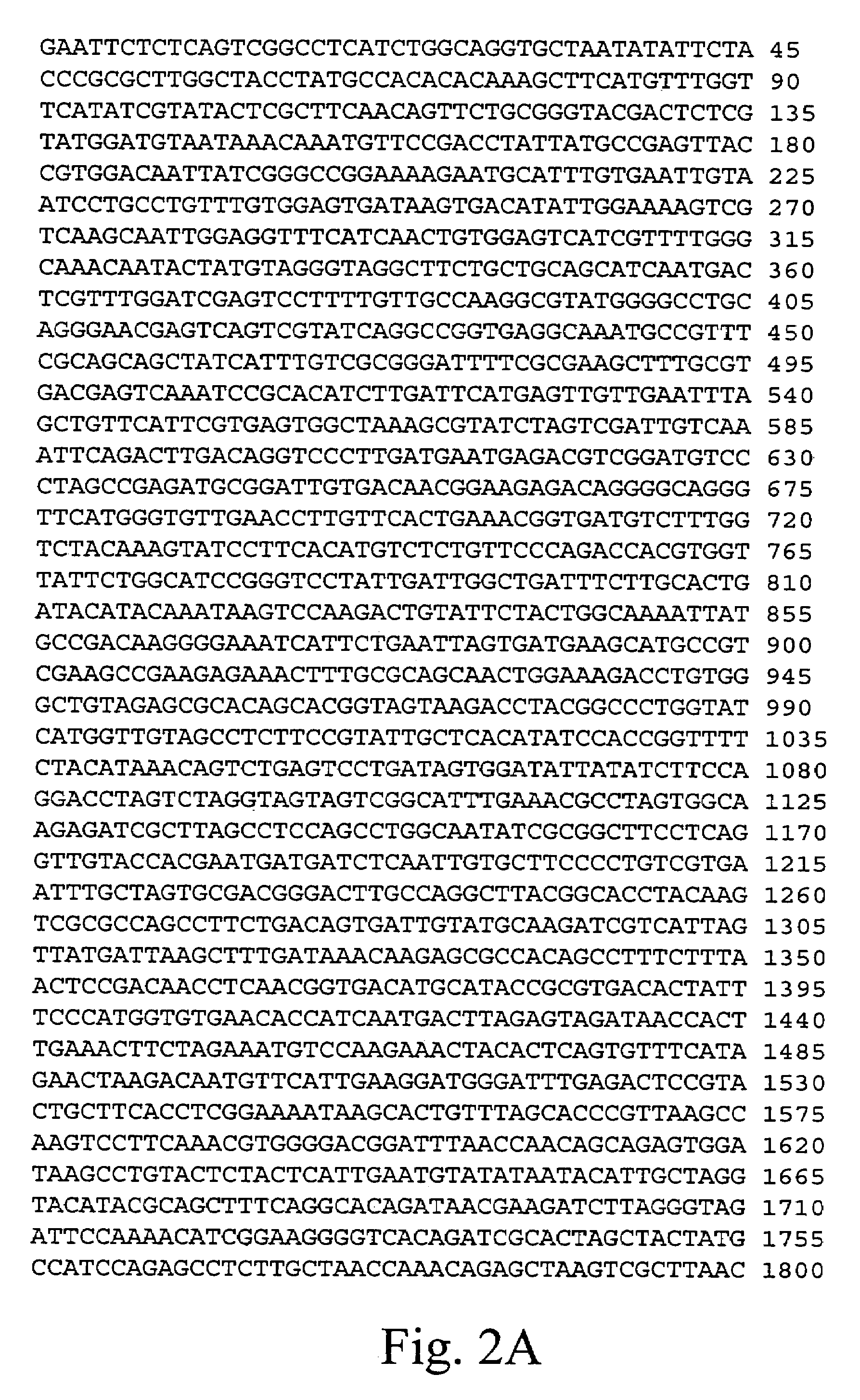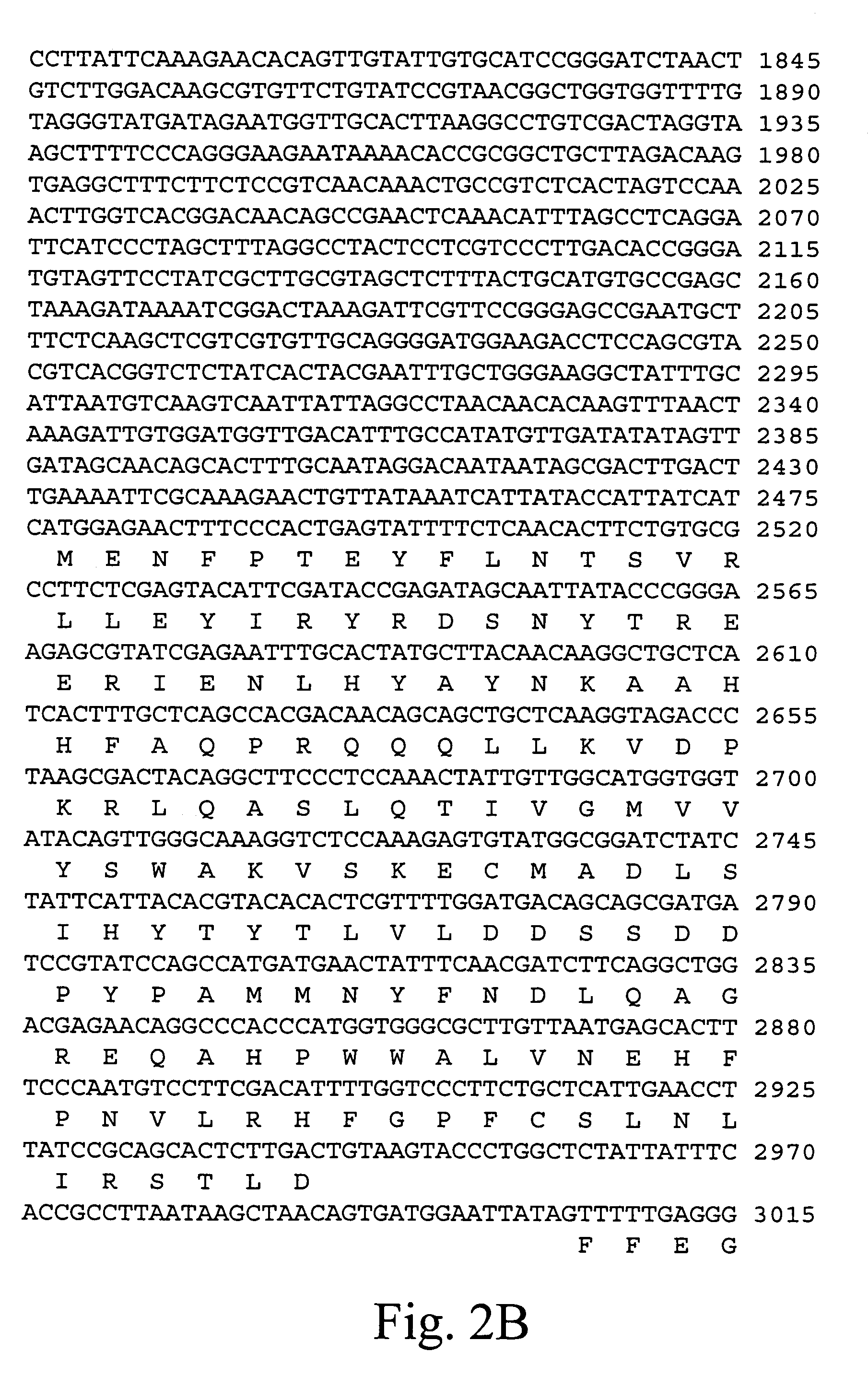Methods for producing heterologous polypeptides in trichothecene-deficient filamentous fungal mutant cells
a filamentous fungal mutant and polypeptide technology, applied in the field of producing heterologous polypeptides in trichothecene-deficient filamentous fungal mutant cells, can solve problems such as detriment in humans, and achieve the effect of reducing the production of the first polypeptid
- Summary
- Abstract
- Description
- Claims
- Application Information
AI Technical Summary
Benefits of technology
Problems solved by technology
Method used
Image
Examples
example 1
Fusarium venenatum ATCC 20334 Genomic DNA Extraction
[0188]Fusarium venenatum ATCC 20334 was grown in 25 ml of YEG medium for 24 hours at 28° C. and 150 rpm. Mycelia were then collected by filtration through Miracloth (Calbiochem, La Jolla, Calif.) and washed once with 25 ml of 10 mM Tris-1 mM EDTA (TE) buffer. Excess buffer was drained from the mycelia which were subsequently frozen in liquid nitrogen. The frozen mycelia were ground to a fine powder in an electric coffee grinder, and the powder was added to 20 ml of TE buffer and 5 ml of 20% w / v sodium dodecylsulfate (SDS) in a disposable plastic centrifuge tube. The mixture was gently inverted several times to ensure mixing, and extracted twice with an equal volume of phenol:chloroform:isoamyl alcohol (25:24:1 v / v / v). Sodium acetate (3 M solution) was added to give a final concentration of 0.3 M and the nucleic acids were precipitated with 2.5 volumes of ice cold ethanol. The tube was centrifuged at 15,000×g for 30 minutes and the ...
example 2
Preparation of a Fusarium venenatum ATCC 20334 Trichodiene Synthase Probe
[0190]Based on the conserved amino acid sequences of the trichodiene synthases from Fusarium sporotrichioides, Fusarium poae, and Gibberella pulicaris, the oligonucleotide primers shown below were synthesized with an Applied Biosystems Model 394 DNA / RNA Synthesizer, according to the manufacturer's instructions, to PCR amplify a trichodiene synthase gene fragment from Fusarium venenatum ATCC 20334 genomic DNA.
[0191]
Primer 1:5′-GGCTGCTCATCACTTTGCTC-3′(SEQ ID NO. 3)Primer 2:5′-TGCATGAAGCACTCAATCGT-3′(SEQ ID NO. 4)
[0192]Amplification reactions (50 μl) were prepared using approximately 0.8 μg of Fusarium venenatum genomic DNA, prepared as described in Example 1, as the template. Each reaction contained the following components: 0.8 μg of genomic DNA, 40 pmol of primer 1, 40 pmol of primer 2, 200 μM each of dATP, dCTP, dGTP, and dTTP, 1× Taq DNA polymerase buffer (Perkin-Elmer Corp., Branchburg, N.J.), and 2.5 Units ...
example 3
DNA Libraries and Identification of tri5 Clones
[0194]Genomic DNA libraries were constructed using the bacteriophage cloning vector λZipLox (Life Technologies, Gaithersburg, Md.) with E. coli Y1090ZL cells (Life Technologies, Gaithersburg, Md.) as a host for plating and purification of recombinant bacteriophage and E. coli DH10Bzip (Life Technologies, Gaithersburg, Md.) for excision of individual pZL1-tri5 clones. Total cellular DNA was partially digested with Tsp509I and size-fractionated on 1% agarose gels. DNA fragments migrating in the size range 3-8 kb were excised and eluted from the gel using Qiaex (Qiagen Inc., Chatsworth Calif.). The eluted DNA fragments were ligated with EcoRI-cleaved and dephosphorylated λZipLox vector arms (Life Technologies, Gaithersburg, Md.), and the ligation mixtures were packaged using commercial packaging extracts (Stratagene, La Jolla, Calif.). The packaged DNA libraries were plated and amplified in Escherichia coli Y1090ZL cells (Life Technologies...
PUM
| Property | Measurement | Unit |
|---|---|---|
| Tm | aaaaa | aaaaa |
| pH | aaaaa | aaaaa |
| concentration | aaaaa | aaaaa |
Abstract
Description
Claims
Application Information
 Login to View More
Login to View More - R&D
- Intellectual Property
- Life Sciences
- Materials
- Tech Scout
- Unparalleled Data Quality
- Higher Quality Content
- 60% Fewer Hallucinations
Browse by: Latest US Patents, China's latest patents, Technical Efficacy Thesaurus, Application Domain, Technology Topic, Popular Technical Reports.
© 2025 PatSnap. All rights reserved.Legal|Privacy policy|Modern Slavery Act Transparency Statement|Sitemap|About US| Contact US: help@patsnap.com



